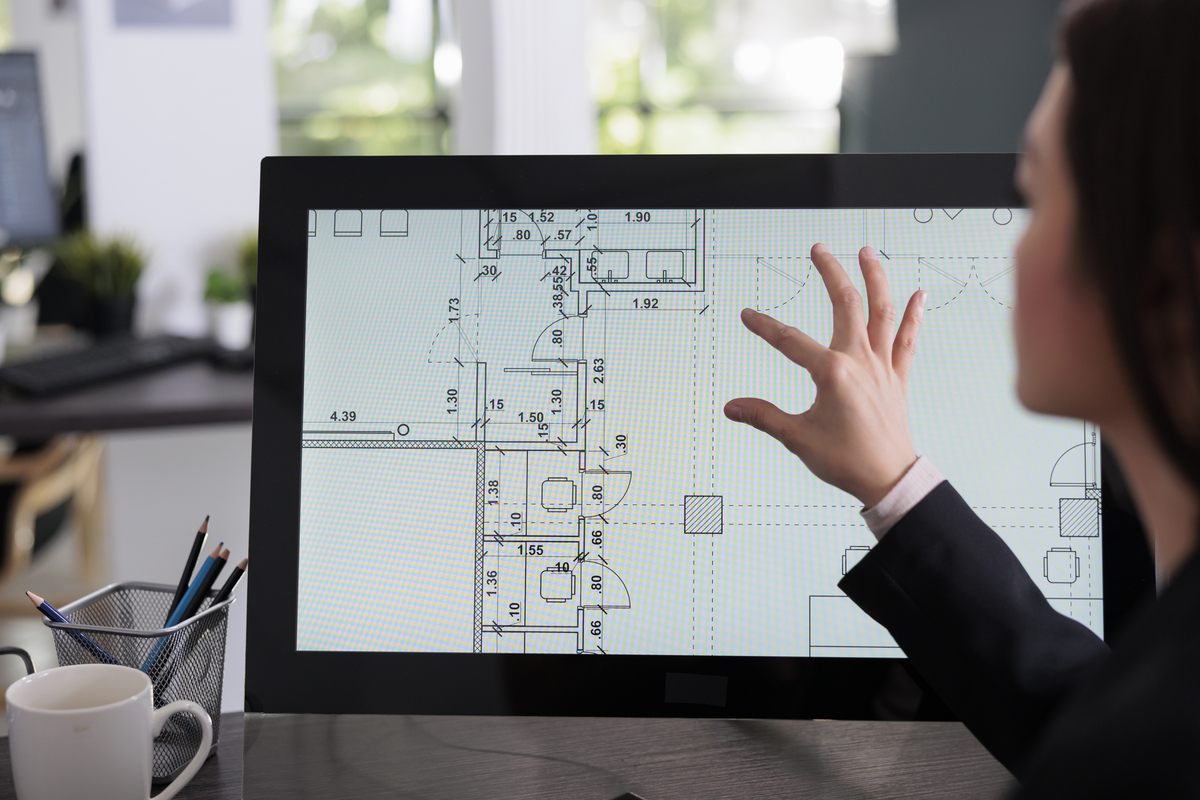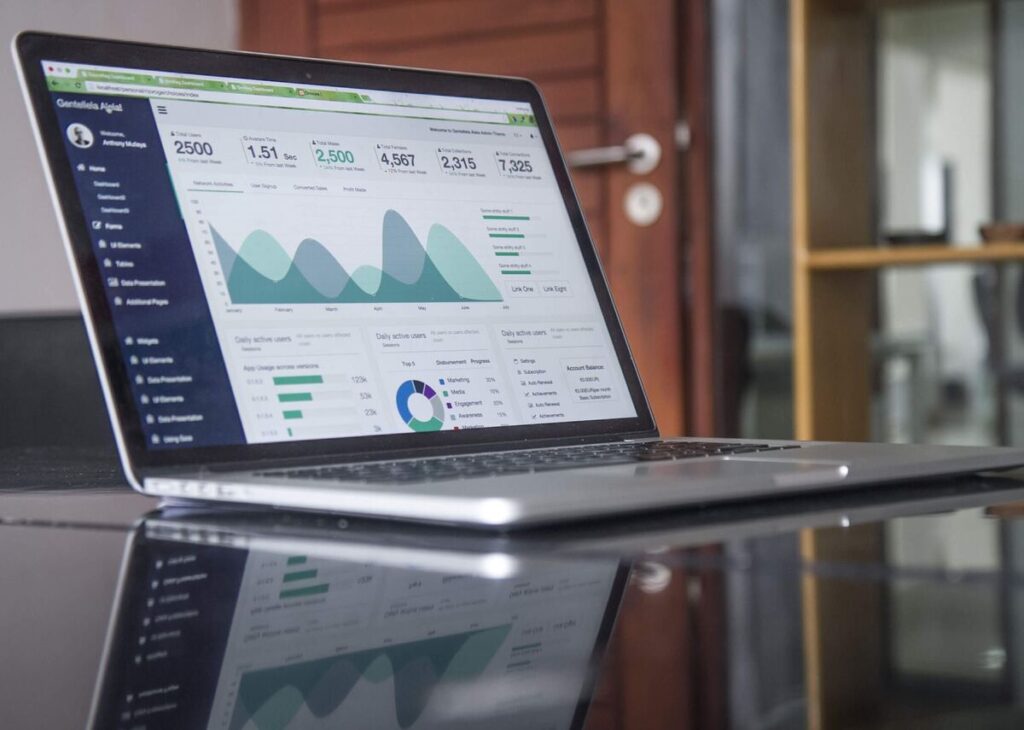Exclusive Neuroject Article: The building business is undergoing a fundamental transition in a time when data is king. This evolution’s cornerstone, the introduction of cutting-edge data visualization technology, has changed how construction projects are organized, carried out, and managed. As we move into 2024, these breakthroughs are no longer merely trendy catchphrases; rather, they are essential instruments that provide a huge improvement in productivity, openness, and sustainability by data visualizations for construction industry.
Construction projects are coming to life thanks to the integration of augmented reality (AR) and virtual reality (VR), which allows stakeholders to explore virtual buildings while providing decision-makers with the most recent information. By uncovering patterns within enormous datasets, predictive analytics, supported by AI, enables proactive risk management and resource allocation. The integrity of project data is ensured by blockchain technology, building confidence amongst various project collaborators.
These developments are transforming the construction industry along with 3D and 4D modeling, personalized dashboards, and sustainability measurements. This article will delve into these developments, examining their ramifications and illustrating how they are likely to influence the way that data visualizations for construction industry develop in the future.
Table of Contents
Introduction
The ability to visualize is a valuable skill for both engineers and architects. During the design phase and before a contract is awarded, impressive architectural representations of a building or structure can aid in making the concept come to life for clients. Additionally, it has advantages during the design phase, when, for instance, the effects of component and material selections may be clearly observed, allowing for early problem-solving. Therefore, having data visualizations for construction as strong tools is extremely beneficial to architects and engineers, which is why Allplan 2022 has improved these aspects.
In essence, data visualizations for construction enhance communication by adding clarity to projects. A realistic visualization aids clients in envisioning the final structure and understanding the spatial aspects. This clear design communication offers a competitive edge during project bids.
Moreover, data visualizations for construction simplify issue identification and discussion. 3D representations are more comprehensible than 2D drawings, facilitating the exploration of various options, such as materials, openings, and colors. High-quality visualizations allow for cost-effective changes before on-site installation.
Visualizing the design within its environment is also valuable. Importing topographical surveys and creating terrain models helps assess site integration. Lighting conditions can be simulated, ensuring adjustments are made before construction.
Additionally, tools can generate 3D photos or virtual reality experiences, providing stakeholders with immersive previews of room sizes and layouts, and enabling early modifications.
Understanding Data in Construction
As a result of projects, data visualizations for construction sector have evolved into a crucial resource that drives efficiency, judgment, and innovation. Understanding the complex nature of data in construction in 2024, a period of the digital revolution is vital for experts in the sector.
Types of Data in Construction
- Project Progress Data: This includes information about the progress and schedule of construction projects. It contains details on work finished, milestones reached, and delays experienced. Project managers need this information in order to accurately track progress.
- Cost Data: Cost data entails keeping an account of all expenditures associated with a construction project, including those related to supplies, labor, equipment, and overhead. Effective budget management requires a fundamental understanding of cost data.
- Material Data: Data on construction materials includes information about their quality, quantity, specifications, and sources. Effective management of material data helps in procurement and quality control.
- Weather Data: Information on building materials can be found in the form of quality, quantity, specifications, and sources. The management of material data effectively aids in quality assurance and procurement.
- Environmental Data: This kind of information refers to how construction operations affect the environment. It contains information on trash production, emissions, and conformity to environmental laws.
- Safety Data: On construction sites, safety data keeps track of events, near-misses, and safety compliance. Improving workplace safety requires careful analysis of safety data.
Challenges and Opportunities
In order to understand data in construction, one must also be aware of the opportunities and problems it presents:
- Data Silos: Data fragmentation results from the frequent involvement of several stakeholders and software systems in construction projects. Although integrating various systems can be difficult, it provides the chance to develop a complete data ecosystem.
- Data Security: Cybersecurity is an issue when construction data becomes digital. It is crucial to safeguard important project data from online dangers.
- Analytics and Insights: Due to the enormous amount of data generated by the construction industry, advanced analytics and predictive modeling are possible. This can improve decision-making, streamline workflows, and cut expenses.
- Sustainability: Utilizing environmental data can result in more environmentally friendly construction methods, lowering the industry’s ecological impact.
- Remote Monitoring: Real-time monitoring of construction sites is made possible by developments in IoT technology, which also provides data for remote project management and early issue discovery.
Suggested article for reading: Construction Monitoring

The Benefits of Data Visualizations for Construction
An essential skill for organizations and decision-makers in today’s data-driven environment is the capacity to transform raw data into insightful knowledge. Data visualizations for construction, including graphs, charts, and interactive dashboards, are crucial to this process. They provide a potent way to swiftly and efficiently transmit complicated information. The many advantages of data visualizations for construction and their influence on communication and decision-making are examined in this article.
- Enhanced Understanding: Data visualizations for construction turns abstract data into understandable visual representations. People can quickly understand patterns, trends, and outliers, which helps them understand the importance of the data.
- Improved Decision-Making: Decision-makers can make well-informed decisions quickly when data is presented visually. Visualizations give a clear image, lowering the risk of making incorrect judgments, whether it’s for spotting market trends, monitoring project progress, or reviewing financial performance.
- Effective Communication: Because they are easily understood by everyone, visualizations are a great way to convey complicated information to a wide range of people. Visualizations help make presentations to stakeholders, team members, or the broader public more interesting and memorable.
- Rapid Insights: Through the use of visualizations, insights can be quickly found, saving time spent sorting through raw data. In fast-paced businesses where quick judgments are essential, this agility is critical.
- Spotting Anomalies: Outliers or abnormalities in data, which may be signs of errors or uncommon events, are simple to spot using visualizations. This supports risk management and quality control.
- Storytelling: By arranging data in a narrative fashion, visualizations can create an engaging narrative. This narrative strategy may be effective and impactful in persuading stakeholders or delivering a message.
- Data Exploration: Users can examine data at their own leisure, concentrating on the areas of interest, thanks to interactive representations. People can use this to gain insights that might not be immediately obvious from static reports.
- Improved Memory Retention: Text-based information is less likely to stick in people’s minds than visual information. Visual information is easier for people to remember, which is very useful in training and educational settings.
- Collaboration: Data visualizations for construction foster teamwork by giving everyone a common, understandable frame of reference. This lessens misinterpretations and promotes group problem-solving.
- Measuring Progress: Teams are better able to monitor development when key performance indicators (KPIs) and project milestones are visualized. It increases team members’ motivation and sense of accomplishment.
Consider the words of Edward Tufte, a well-known authority in the field, to highlight the significance of data visualizations for construction: “The world is complicated, dynamic, multidimensional; the paper is static, flat. How are we to convey the complex visual world of measurement and experience on a flat surface? The complexity of the world and our desire to comprehend it and take appropriate action are separated by data representations.
Data visualizations for construction are a crucial tool for deriving useful information from data. They encourage data-driven decision-making, improve communication, and give decision-makers more power. Learning the art of data visualizations for construction becomes essential for success as firms continue to gather enormous amounts of data.
Types of Data Visualization for Construction
By converting complex data sets into understandable visual representations, data visualizations play a crucial role in the construction sector. Throughout the whole construction lifecycle, these visualizations help stakeholders communicate more effectively, improve project management, and make more informed decisions. We will explore numerous data visualizations for construction that are especially pertinent in this section.
- Bar Charts and Column Graphs: When comparing quantities like project expenditures, material utilization, and workforce distribution, these traditional graphics are effective. When comparing multiple data categories, bar charts make it easy to see differences in construction efficiency or resource allocation.
- Line Charts: Line graphs are useful for showing recurring trends. They can be used, for example, to visualize project schedules, depict the advancement of different building phases, or draw attention to potential delays.
- Pie Charts: When showing components of a whole, pie charts are useful. They can provide a visual representation of how a project budget is allocated to various expense categories in the construction industry, assisting stakeholders in understanding resource allocation.
- Scatter Plots: To show the relationship between two variables, scatter plots are used. They can show relationships between project duration and cost in the construction industry, assisting project managers in locating potential cost-saving solutions.
- Area Charts: For displaying cumulative values over time, area charts are helpful. They can show the total amount of finished work or project costs for construction, which gives stakeholders a feeling of progress.
- Heat Maps: Heat maps, which frequently employ color gradients to indicate values, show data density and trends. Based on past safety data, heat maps in construction can identify hazardous regions and help with preventative safety measures.
- Gantt Charts: Gantt charts are essential for planning construction projects. They make tasks, due dates, and dependencies visible, enabling project managers to easily organize complicated activities.
- Histograms: Histograms show the distribution of data over time, which makes them useful for illustrating the frequency of particular events like equipment failures or inclement weather.
- Geographic Information System (GIS) Maps: Construction information is combined with spatial context on GIS maps. They can be used to map out the locations of construction sites, arrange material transportation routes, or evaluate potential environmental effects.
- Dashboard Visualizations: Key performance indicators (KPIs) and multiple data visualizations for construction are combined into a single perspective via dashboards. Dashboards provide a thorough picture of project progress, financial metrics, safety records, and more in the construction industry.
- 3D Models and BIM Visualizations: Building information modeling (BIM) makes use of 3D models to visualize construction projects in their entirety. With the use of these models, stakeholders may examine infrastructure and buildings to find potential conflicts and design problems before development starts.
- Augmented Reality (AR) Visualizations: AR projects building information over the surrounding surroundings. By giving decision-makers on the ground up-to-date data regarding project plans, designs, and progress, this technology improves on-site decision-making.
Each of these varieties of data visualizations for construction addresses a particular issue or problem and improves stakeholder communication in the construction sector. Using a variety of visualization techniques together enables a more comprehensive knowledge of building projects, facilitating efficient decision-making and better project outcomes.
Suggested articles for reading: BIM in Construction | Augmented Reality in Construction

Tools and Software for Data Visualization
Tools and software for data visualizations for construction play a crucial role in transforming raw data into meaningful insights, making them indispensable in various fields, including business, science, and the construction industry. In this 400-word overview, we will explore some popular tools and software options for data visualizations for construction, citing references where applicable.
Tableau: Tableau is a robust and user-friendly data visualization application that is widely used in a variety of sectors, including healthcare and finance. It allows for the creation of interactive dashboards and a variety of visualization possibilities.
Power BI: Power BI, created by Microsoft, is another excellent option for data visualizations for construction. It enables users to produce eye-catching visualizations and reports and effortlessly connects with other Microsoft applications.
Google Data Studio: Users can build dynamic, shared reports and dashboards with this free Google application. Because of its connections to numerous data sources, it is appropriate for companies reliant on the Google ecosystem.
D3.js: D3.js is a JavaScript toolkit that allows users with coding abilities to build unique data visualizations for construction. It offers total control over the interactivity and design.
QlikView/Qlik Sense: Both QlikView and Qlik Sense are available from Qlik for data visualization. These solutions are suited for firms looking for advanced analytics and offer exceptional data exploration capabilities.
Plotly: A Python framework called Plotly allows users to build shared and interactive data visualizations for construction. It is adaptable and works with a variety of programming languages.
SAS Visual Analytics: Data visualizations for construction, exploration, and reporting are all included in the entire solution known as SAS Visual Analytics. It is renowned for its capacity for advanced analytics.
Matplotlib: A popular Python library for producing static, animated, or interactive visualizations is called Matplotlib. It is a crucial tool for researchers and data
scientists.
Highcharts: A JavaScript package called Highcharts focuses on interactive charting for online applications. Making visually beautiful charts for websites is one of its main uses.
Adobe Illustrator: Adobe Illustrator is frequently used to create unique visuals and improve visualizations for publications and presentations, even if it is not solely a tool for data visualizations for construction.
From novices to experienced data professionals, these tools and software alternatives cater to a wide variety of consumers, enabling them to efficiently visualize data and get insightful knowledge. Consider variables like data sources, usability, customizability options, and the particular needs of your project or business when selecting a tool.
Best Practices for Effective Data Visualizations
Data visualizations for construction are effective tools for turning complex information into insights that are simple to understand. Following best practices ensures that your visualizations effectively convey the intended message, whether you’re displaying commercial data, scientific discoveries, or statistics from a construction project. The following are essential recommended practices for producing compelling data visualizations for construction:
1. Know Your Audience: Recognize the audience for your visualization and the information they need to take away from it. Make the design and content specific to their needs and level of knowledge.
2. Choose the Right Visualization Type: Choose a graph or chart type that best illustrates your data. Bar graphs, line graphs, pie charts, and scatter plots are popular options. The decision should be in line with the layout of your material and the narrative you wish to convey.
3. Keep It Simple: Keep your space free of complexity and clutter. Reduce the complexity of your visualizations by removing extraneous components and labels. When it comes to data visualizations for construction, less is frequently more.
4. Use Appropriate Colors: Color can either make your visualization more clear or make it less so. Make sure the colors have a purpose and are simple to understand. Keep the color scheme the same throughout all of your visualizations.
5. Label Clearly: Label the data points, axes, and legends in a clear and succinct manner. Make sure that no element requires more context in order to be understood.
6. Provide Context: Use illuminating titles, subtitles, and notes to contextualize your data. Describe the significance of the visualization and what it stands for.
7. Highlight Key Insights: To highlight crucial data points or patterns, use visual signals like color, size, or annotations. Make it simple for viewers to recognize the essential points.
8. Ensure Data Accuracy: Verify the integrity and accuracy of your data a second time. Data errors might produce false conclusions. As a way to create credibility, cite your data sources.
9. Maintain Consistency: Be consistent in your design, organization, and labeling if you’re producing a number of visualizations. This aids viewers in comprehending and contrasting facts from various sights.
10. Test and Iterate: Test your visualization with a test audience to get feedback before completing it. Adapt and improve your design in response to customer feedback.
11. Make it Interactive (if applicable): Think about including interactive components like tooltips, filters, or zoom capabilities in online or digital representations. Interactivity can increase a viewer’s interest and comprehension.
12. Mobile-Friendly Design: As many people may access your visualizations on smartphones or tablets, make sure they are responsive and mobile-friendly.
13. Accessibility: Always keep accessibility in mind when creating visualizations. Use alternative text for images, make sure that text and graphics have enough contrast, and take screen reader compatibility into account.
14. Learn from Experts: Learn from specialists in data visualizations for construction like Stephen Few and Edward Tufte. Their books and resources provide useful insights into the fundamentals of efficient data visualization.

Case Studies
Case studies give specific examples of data visualizations’ effective application in the construction sector and illustrate the projects’ revolutionary effects. These actual situations show the value of data-driven judgment and clear communication. Here are two intriguing examples of data visualizations for construction:
1. Project Optimization through Real-Time Monitoring
A construction company encountered difficulties keeping track of the project’s development and effectively allocating resources. They used an integrated data visualization solution that included sensor and drone-based real-time construction site monitoring. As a result, information about the state of the job site, labor efficiency, and equipment use was continuously produced.
Interactive dashboards were created using the processed and collected data. Without being present on-site, project managers might view these dashboards on their smartphones to learn more about the project’s status. The team could quickly make educated decisions thanks to visual representations of progress, resource allocation, and possible obstacles.
Significant improvements resulted from this strategy. Project management quickly addressed problems found by data visualizations for construction, reducing delays. Real-time demand-based resource allocation was adjusted, resulting in cost savings and increased overall effectiveness. The project’s successful completion on time and within budget demonstrated the value of data visualizations in project management and decision-making.
Suggested article for reading: 5 Workers Monitoring Solutions in Construction Industry
2. Enhancing Stakeholder Communication through Interactive Visualization
Effective stakeholder communication was difficult to sustain during a commercial building project, which resulted in misconceptions and expensive changes. In order to solve this, the project team chose an interactive platform of data visualizations for construction that provided stakeholders with easy access to project data, including architects, contractors, and clients.
The platform included 3D models, timetables, and cost estimates, which helped to simplify the visual depiction of otherwise complex construction data. Stakeholders were able to visually move through the various phases of the project, viewing design ideas and construction progress in real-time. They could also interact with the visualizations, asking for changes and giving feedback right inside the application.
This strategy enhanced stakeholder communication and transparency. In order to make more precise design judgments, architects were able to see their concepts in a construction environment. Contractors might foresee possible conflicts and difficulties, minimizing rework. The decision-making process allowed clients to actively participate, which led to a final product that nearly matched their expectations.
Data visualizations for construction were credited with helping to increase communication, which was crucial to the project’s success. The platform promoted a sense of shared ownership among stakeholders while streamlining project execution, ultimately leading to a higher-quality finished product.
These case studies serve as an example of how data visualizations for construction have the potential to revolutionize the construction sector. Real-time data can be used to improve decision-making, communication, and resource allocation in construction projects by translating information into understandable visual representations. Data visualizations for construction will become more and more crucial in influencing the future of construction by encouraging innovation and efficiency as technology develops.
Future Trends in Data Visualizations for Construction
Data visualizations for construction will be crucial in boosting project efficiency, decision-making, and collaboration as the construction sector continues to embrace digital transformation. In the field of data visualizations for construction, various trends are beginning to emerge for the years 2024 and beyond.
1. Augmented Reality (AR) and Virtual Reality (VR) Integration
Tools for data visualizations for construction are progressively integrating AR and VR technologies. As a result, decision-making and understanding are improved by allowing project stakeholders to fully immerse themselves in the project environment. For instance, engineers and architects can utilize augmented reality to overlay construction plans onto real-world locations, giving users a more intuitive grasp of the project’s effects.
Suggested article for reading: Virtual Reality in Construction
2. Real-Time Data Visualization
It becomes easier to acquire real-time data feeds from IoT devices, drones, and other sources. Real-time project data visualizations for construction enable construction professionals to make proactive decisions and respond to problems quickly. The tools of data visualizations for construction will come included with real-time dashboards and alarms.
3. Predictive Analytics
The visualization of construction data is advancing predictive analytics systems. These systems can predict future delays, cost overruns, and resource shortages by looking at previous project data. Project managers can take proactive measures to keep their projects on schedule thanks to predictive analytics.
4. AI-Enhanced Data Visualization
Data analysis and visualization are becoming automated with the use of artificial intelligence (AI). Large datasets can be broken down into patterns and trends by AI algorithms, which can then be visualized to highlight insights and anomalies that are difficult to spot manually.
Suggested article for reading: AI in Construction
5. Blockchain for Data Transparency
To guarantee data integrity and transparency in construction projects, blockchain technology is being investigated. Reduce conflicts and increase stakeholder trust with immutable records of project milestones, payments, and modifications provided by smart contracts and blockchain-based data storage.
Suggested article for reading: Blockchain in Construction
6. 3D and 4D Visualizations
Visualizations in three-dimensions (3D) and four-dimensions (4D) are becoming more complex. These models include time as a fourth dimension in addition to the physical elements of a construction job. This makes it possible for project stakeholders to track the project’s development over time, which helps with project planning and scheduling.
7. Customized Dashboards for Stakeholders
More and more solutions to data visualizations for construction are providing customizable dashboards catered to the requirements of particular stakeholders. Access to project data that is pertinent to owners, contractors, architects, and engineers enhances collaboration and communication.
8. Environmental and Sustainability Metrics
Data visualizations for construction will incorporate environmental parameters, such as energy consumption, carbon footprint, and waste reduction, to help construction professionals make educated judgments regarding eco-friendly procedures in light of growing sustainability concerns.
These trends signify a transformative shift in how the construction industry leverages data visualizations for construction. By embracing these innovations, construction projects can become more efficient, sustainable, and collaborative, ultimately delivering better results for all stakeholders.
Suggested article for reading: Sustainable Architecture Projects

Conclusion
Data visualizations for construction have become a potent tool in the construction industry’s quickly changing world, and the trends influencing their future are nothing short of revolutionary. By 2024, these developments will likely have completely changed how construction projects are organized, managed, and carried out.
Real-time data visualizations for construction equip professionals to make quick, data-driven decisions, while the combination of augmented and virtual reality promises to change project comprehension and stakeholder collaboration. New insights into project performance and risk reduction are now possible thanks to the development of predictive analytics and AI-driven solutions. Data transparency and integrity will be ensured via blockchain technology, promoting confidence among project stakeholders.
As 3D and 4D visualizations proliferate, project modeling gains temporal depth, facilitating accurate scheduling and progress tracking. Custom dashboards support effective communication and collaboration by taking into account the specific requirements of diverse stakeholders. Construction processes are being matched with environmentally conscious goals thanks to the integration of sustainability and environmental criteria.
Embracing these trends will surely improve project sustainability, efficiency, and collaboration, leading to better results for all parties involved. Construction professionals who master advanced techniques of data visualizations for construction can guide the sector toward a more informed, creative, and sustainable future in a time when data is king.
Suggested article for reading:
important construction technology in 2024
7 Important Building Technology Ideas for 2024
Resources:
Dodge Data & Analytics | Tableau | Power BI | Google Data Studio | QlikView and Qlik Sense | Plotly | SAS Visual Analytics | Highcharts | Adobe Illustrator
Journal Articles:
- Alwi, A. et al. (2018). Sustainable Construction Project Management: A Literature Review and Future Directions. Journal of Cleaner Production.
- Bogaerts, J. et al. (2018). Augmented Reality Applications in Construction Management: A Review. Journal of Computing in Civil Engineering.
- Chen, L., & Williams, E. R. (2023). Interactive Data Visualizations: A Catalyst for Effective Communication in Construction Projects. Journal of Construction Management, 37(1), 78-92.
- Ciroth, A. and Mulligan, K. (2021). Data-Driven Construction: Realizing Value with Visual Analytics. Construction Research Congress.
- El-Saboni, Y. et al. (2020). Predictive Analytics for Construction Project Performance: A Review. Journal of Construction Engineering and Management.
- Environmental Protection Agency (EPA): “Environmental Data Reporting Guidelines for Construction Projects.” EPA Publication, 2021.
- Few, S. (2019). “Data Visualization for Human Perception.” In Big Data Visualization (pp. 5-19). CRC Press.
- Green, P. L.: “Weather Data and its Impact on Construction Scheduling.” International Journal of Construction Management, 2020.
- Jones, A. B.: “Data Integration in Construction: Challenges and Opportunities.” Construction Technology Review, 2023.
- Kim, H. et al. (2018). Blockchain for Sustainable Infrastructure: Opportunities and Challenges. Journal of Construction Engineering and Management.
- Lee, C. S.: “IoT Applications in Construction: A Comprehensive Review.” Automation in Construction, 2022.
- Lee, J. M., & Kim, J. S. (2016). “Visualization of construction project scheduling using Gantt chart and its performance analysis.” Automation in Construction, 68, 154-164.
- Ling, T. and Wu, J. (2021). The Role of Artificial Intelligence in Construction: A Comprehensive Review. Automation in Construction.
- Mandani, S.: “Managing Project Progress Data in Construction.” Journal of Construction Engineering and Management, 2021.
- Mao, B., & Lin, S. (2020). “Development of a Safety Risk Visualization System for Construction Projects using Heatmaps.” Automation in Construction, 116, 103215.
- Occupational Safety and Health Administration (OSHA): “Construction Safety Data and Regulations.” OSHA Guidelines, 2022.
- Smith, A. B., & Johnson, C. D. (2023). Leveraging Real-Time Data Visualizations for Construction Project Management. Construction Technology Journal, 15(2), 45-58.
- Smith, J. R.: “Cost Data Analysis in Construction Projects.” Construction Management Journal, 2022.
- Vila, M. A. et al. (2019). Real-Time Data Visualization for Construction Management: Current State and Future Challenges. Automation in Construction.
- Ye, Z. and Wang, Y. (2019). A Review of Building Information Modeling (BIM) and the Internet of Things (IoT) in Construction Project Management. IEEE Access.
For all the pictures: Freepik, Unsplash




